Accessible Tourism in Seoul
Seoul Danurim Tourism Center
The Seoul Metropolitan Government and the Seoul Tourism Organization operate the Seoul Danurim Tourism Center, a comprehensive tourism information center tailored for tourists with disabilities, the elderly, pregnant women, infants, and their companions. This ensures that everyone can conveniently travel to Seoul.
- Operating Hours : Weekdays 9:00 - 18:00 (Closed on public holidays) / Languages Offered : Korean , English
- Address : 1F, Hana Insurance Building, 117 Changgyeonggung-ro, Jongno-gu, Seoul
- Website: www.seouldanurim.net/en
- Contact : 1670-0880
- Main Services:
· Consultation and information on accessible tourism
· Distribution of promotional materials on accessible tourism
· Operation of Danurim buses and minivans equipped with wheelchair lifts
· Rental of travel aids such as power wheelchairs, beach wheelchairs, and portable ramps
· Operation of information kiosks equipped with screen magnifiers and trackball mice
· Creation of awareness-enhancing content for tourists with special needs
Arrival at Incheon International Airport
Incheon Int'l Airport, recognized as the world's top airport for service for 12 consecutive years, provides a variety of facilities and services for travelers with special needs. However, the services offered by different airlines can vary and are subject to change, so it is advisable to check the respective airline and Incheon Int'l Airport websites for the most up-to-date information.
Using one of the help phones located throughout the passenger terminal at entry gates 3, 7, 8 & 12, will connect you directly with the Airport Help Desk if you are in need of any assistance. Wheelchairs can be rented for free at the information desks on the departure level at entry gates 3 & 12, or the arrival level at entry gates 5 & 10.
- Incheon International Airport Help Desk
Tel: 02-1577-2600 (+82-2-1577-2600)
- Incheon Int'l Airport Website
https://www.airport.kr/ap/en/index.do
- Incheon Int'l Airport Dedicated Website
https://www.airport.kr/ap_lp/en/svc/cusserv/servtra/servtra.do
*For in-flight services, please contact the respective airline.
Getting to Seoul
Airport Railroad Express
The Airport Railroad (AREX) connects Incheon Int'l Airport and Gimpo Int'l Airport to downtown Seoul (Seoul Station). Passengers on the express train can reach downtown Seoul from Incheon Int'l Airport in about 40-50 minutes without any stops. All stations and trains are fully equipped with facilities for people with disabilities, and each train has designated wheelchair areas.
> More about the Airport Railroad
Airport Bus
The airport limousine bus conveniently transports passengers to major hotels and locations throughout downtown Seoul. However, most limousine buses are not equipped for people with disabilities.
Taxi
While taxis are the most expensive mode of transportation, they can be more convenient for some tourists.
> Transportation to Seoul
Getting Around Seoul
Subway
Seoul's extensive subway network allows you to explore the city efficiently. The subway lines are color-coded, and multilingual signs and announcements make it easy for foreign tourists to navigate. Consistently ranked among the best subways in the world, Seoul's subway system is safe, clean, and easy to use and offers excellent accessibility and convenience for visually, hearing, and mobility-impaired passengers at almost all stations and trains. The details are as follows.
- Elevators and escalators
- Wheelchair lifts and ramps
- Hearing and visual guidance systems
- Audio guidance devices and video phones for sign language
- Braille blocks
- Wheelchair-accessible ticket gates in subway stations
- Rapid chargers for electric wheelchairs
- Vending machines for transportation cards for people with disabilities
- Platform gap fillers to bridge the gap between the train and the platform
- Portable safety steps
- Platform screen doors
- Accessible restrooms for people with disabilities
- Priority seating in all train cars
* Note: Some smaller and older subway stations may not have all the accessibility facilities for people with disabilities.
> More about subways
> Accessible features by station
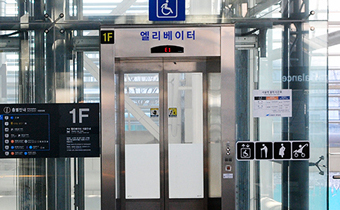
Elevators
Nearly all of Seoul’s subway stations can be accessed by elevator. Most stations will have an elevator that goes from the street level down to the ticketing level. Taking another elevator at the ticketing level is usually required to get down to the platform. If an elevator on the platform/street level has transit card readers, this indicates that it will go all the way up or down. As many elevators have been retrofitted wherever they fit in the older stations, placement may not always be intuitive, but locations are clearly marked with signs. Locations of elevators at street level are usually not marked with signs, but the big glass boxes are fairly easy to spot from a distance.
* Some smaller and older stations have no or partial elevator access.

Wheelchair Access Gate
Most of the newer subway stations have entry gates without turnstiles, but many older stations will still have them. These older stations are equipped with wheelchair access gates. Simply scan your transit card on the sensor and be on your way.
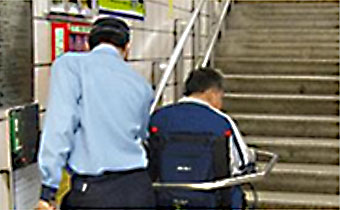
Wheelchair Lifts
For older stations without elevators, wheelchair lifts are available. Simply call for an attendant at the lift for assistance.
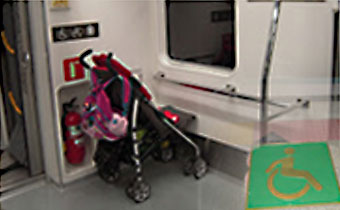
Priority Seating
Every subway car has priority seating at each end for senior citizens and travelers with disabilities. Large green signs on the floor (pictured) indicate which subway cars on each train are accessible. Gaps between the platform and car are negligible and all accessible cars have spaces where wheelchairs and strollers can be parked.

Screen Doors
All Seoul subway stations are equipped with platform screen doors to prevent any accidental slippage onto the tracks. Doors will only open once the train has arrived.
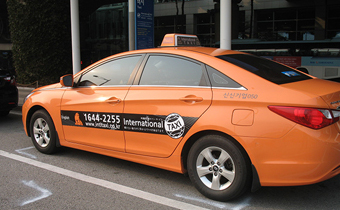
Taxi
Taxis in Korea are some of the world's cheapest and one of the most convenient ways to travel in the city. There are five types of taxis in Seoul: regular, international, deluxe, jumbo, and accessible. The type of taxi can usually be distinguished by its color. Taxis are a great way to travel shorter distances or to locations where accessible subway stations are not in the vicinity.
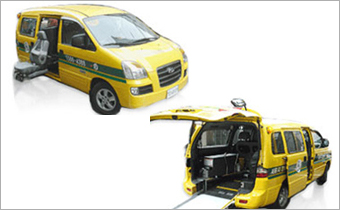
Accessible Ride Taxi Service
Seoul boasts a fleet of wheelchair-accessible taxis for travelers traveling by wheelchair. Accessible taxis are yellow vans, equipped with a ramp or lift, and can accommodate one wheelchair and five passengers. Accessible taxis are only for foreigners traveling by wheelchair (as well as local residents with disabilities) and must be reserved in advance. Unfortunately, the demand for the service is currently much higher than the number of vehicles in the fleet, so expect to wait 30-60 minutes,on average, for pickup.
* As service of accessible taxis may be unreliable, it is not recommended to rely on accessible call vans as your primary mode of transportation.
The Accessible Ride Taxi Service operates 699 vehicles, including 692 call taxis with ramps, four multi-passenger buses with lifts, and three accessible buses. Additionally, 30 private taxis are available (as of 2024). The cost of wheelchair-accessible taxis is up to three times the city rail fare, making them cheaper than regular taxis, with no additional service charges.
- Fares:
- The base fare for up to 5 km: 1,500 KRW
- For distances over 5 km up to 10 km: 2,900 KRW (280 KRW per km)
- For distances over 10 km: an additional 70 KRW per km
- No time or area surcharges apply. / Amounts less than 100 KRW are rounded down.
- Passengers are responsible for parking, tolls, and other necessary fees.
- Operating Hours: 24 hours
- Reservations: Can be made via mobile app, internet, text message, or phone(+82-2-1588-4388).
Regular Taxis
Regular taxis are currently orange, white or gray. These are the most common taxis in the city and can easily be hailed from just about anywhere. Regular taxis are the cheapest, but service is not always the best.
International Taxi
International taxis are marked with the word “International” on the vehicle. They are slightly more expensive than general taxis, but the drivers can speak basic foreign languages such as English, Japanese, and Chinese. Due to their limited number, reserving an international taxi at least a day in advance is usually necessary.
- International Taxi Call Center: +82-2-1644-2255
- Email: reserve@intltaxi.co.kr
- Reservation Website: https://www.intltaxi.co.kr/ (available in Korean, English, Japanese, Simplified Chinese, and Traditional Chinese)
Deluxe Taxi
Deluxe taxis are black with a gold stripe along the side. While more expensive than general taxis, they offer a safer and more comfortable ride. One must have over ten years of accident-free driving experience to qualify as a deluxe taxi driver. Since deluxe taxis are harder to find than general taxis, booking in advance or calling for one is advisable.
*The trunk space of general, international, and deluxe taxis may be limited due to the LPG gas tank, which could prevent accommodating a wheelchair.
Large Taxis
Large taxis are larger than vans, making them convenient for transporting luggage. Although not specifically designed for people with disabilities, their larger size can accommodate a wheelchair if needed. It is usually necessary to book or call in advance.
Taxi Rental
Taxi rental is available for up to a full day. While more expensive, renting a taxi for a designated period can be more convenient than hailing or calling multiple taxis. For those using a wheelchair, it is recommended to rent a large taxi, as general taxis may not have enough trunk space for a wheelchair.
*Accessible Ride Taxis cannot be rented.
> Learn more about taxi services
Bus
Seoul has a highly developed public bus system, making it easy to reach places that are not near subway stations. Starting with 66 low-floor buses in 2004, there are 4,937 low-floor buses in operation as of 2024. By 2025, Seoul plans to introduce low-floor buses on 100% of city bus routes.
Low-floor buses have no steps at the entrance, improving accessibility for the elderly and passengers with mobility impairments. The bus driver deploys a ramp to help passengers park and secure their wheelchairs in the designated area. All public buses have priority seating for the elderly and disabled.
*Due to the limited number of low-floor buses in operation, it may be advisable to use taxis and subways when possible.
In conclusion: The subway is the most economical and efficient means of transportation for long-distance travel, but it may not always be the best option for tourists with mobility impairments. Always check the list of accessibility facilities at the destination, departure, and transfer stations ( link here )). If you use a wheelchair, it is advisable to avoid stations where a wheelchair lift is the only accessible facility. Taxis are ideal for short distances or locations not near a subway station. While general taxis can be hailed anywhere, they may not be able to accommodate wheelchairs. If you plan to visit multiple locations, renting a taxi, although expensive, might be the most convenient option. Accessible Ride Taxis are convenient but may have long waiting times, making them difficult to use. Low-floor buses require checking beforehand as some routes may not be serviced by these buses.
Travel Convenience Services
The Seoul Tourism Organization provides services to ensure convenient travel in Seoul for tourists with special needs. These services include operating Danurim buses/minivans equipped with wheelchair lifts and offering rental services for travel aids. Consultations and services are available through the Seoul Danurim Tourism Center (1670-0880) or the Danurim website ( www.seouldanurim.net ).
- Consultation Hours: Monday to Friday, 9:00 to 18:00
- Eligibility
- Individuals: People with disabilities, seniors aged 65 and above, pregnant women, infants under six years old, and their companions.
- Institutions and Organizations: Non-profit organizations and institutions that conduct activities for tourists with special needs.

Seoul Danurim Bus
It’s designed for non-profit organizations and groups catering to tourists with special needs.
- Vehicle Rental: This service is available on a reservation basis for organizations associated with tourists with special needs for group tourism purposes.
- Vehicle Specifications: 8 wheelchair seats / 21 regular seats (total 29 seats)
※ If necessary, up to 2 minivans can be rented separately or additionally - Capacity: Minimum of 15 people to a maximum of 29 people
- How to Use: Register as an organization or group on the Danurim website ( www.seouldanurim.net ) and use the menu options.

Seoul Danurim Minivan
It’s designed for small groups and individual travelers with special needs.
- Danurim Tour Recommended Travel: Accessible travel courses are selected as recommended courses each month and operated on a reservation basis.
- Danurim Tour Independent Travel: Operates on a reservation basis for small groups requiring a vehicle.
- Vehicle Specifications: 2 wheelchair seats / 7 regular seats (total 9 seats), 4 wheelchair seats / 4 regular seats (total 8 seats)
- How to Use: Register as an individual on the Danurim website ( www.seouldanurim.net ) and use the “Suggested Itineraries” menu.


Travel Aid Rental Service
It’s designed to offer various necessary travel aids, including manual and electric wheelchairs, beach wheelchairs, portable ramps, and strollers.
- Pickup and Return Service: Users can pick up and return the equipment at their desired location in Seoul (vehicle delivery available).
- Usage Period: Free use for up to 15 days per rental (deposit required).
- Eligibility and Scope:
- Seoul residents or organizations/institutions located in Seoul
- Residents or organizations/institutions from other domestic or international regions - How to Use: Register as an individual or organization on the Danurim website ( www.seouldanurim.net ) and use the “Travel Assistance Devices” menu.
Hospitals & Emergency Numbers
In case of a medical emergency, please call 119 . Your location will be automatically tracked, and the call will be connected to an interpreter. Ambulance dispatch is prompt and free of charge.
For other medical information, please call 1339 (02-1339 from mobile phones or outside Seoul). English-speaking doctors and medical information officers provide support.
※ Korean, English, Chinese, and Japanese available 24/7 / Vietnamese, Thai, Malay, Indonesian, and Russian available from 8:00 to 19:00
Additionally, if you call the 1345 Foreigners' Comprehensive Information Center, consultation services are available in 20 languages. (Korean, Chinese, English, Vietnamese, Thai, Japanese, Mongolian, Indonesian/Malay, French, Bengali, Pakistani, Russian, Nepali, Cambodian, Burmese, German, Spanish, Filipino, Arabic, Sinhala)
For more details, please refer to the website:
link ※ For official information on Seoul’s disability welfare policies, please refer to the updated link here






